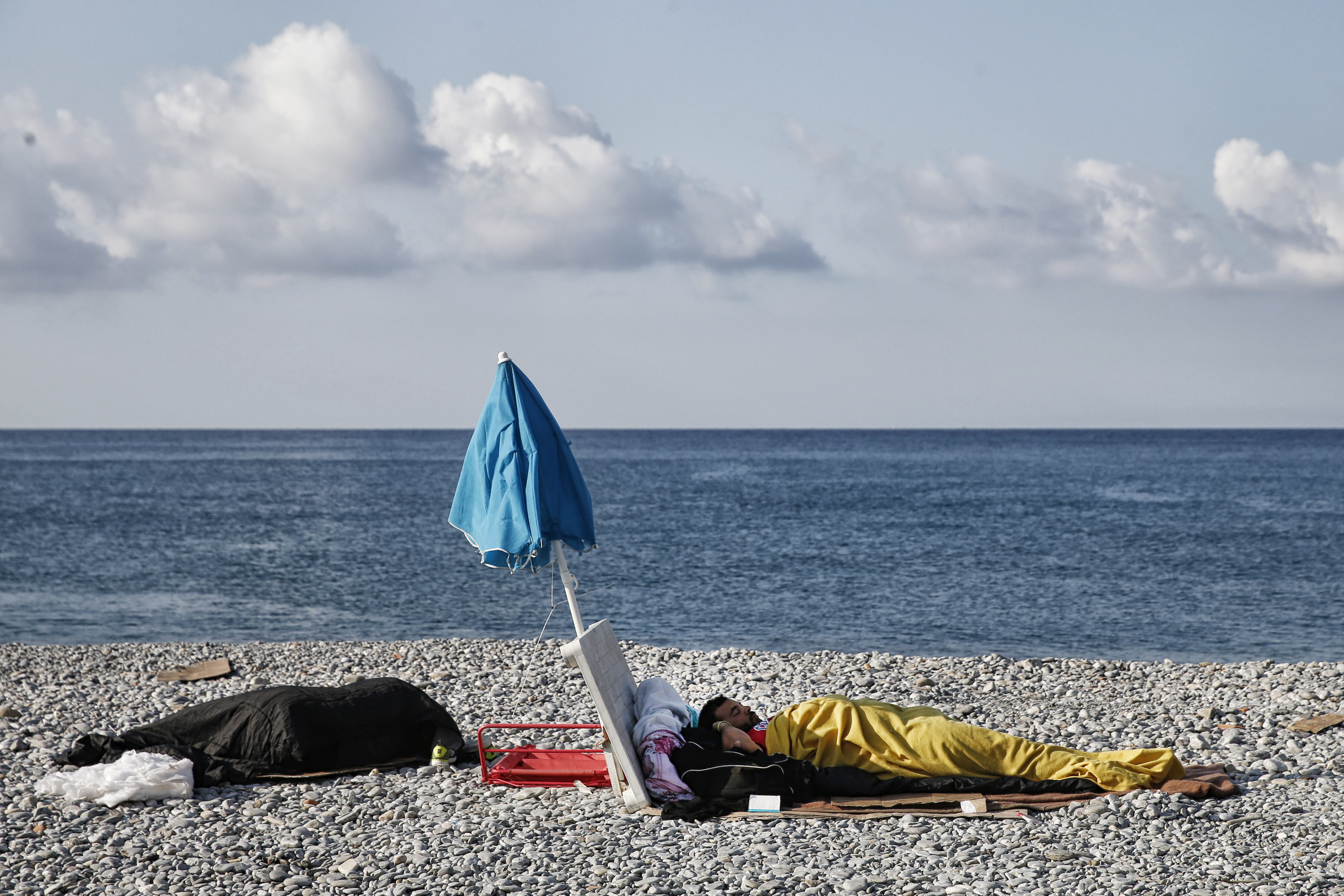
(Photo: Marco Bertorello/AFP/Getty Images)
It’s sometimes called “the ugly border town.” Ventimiglia, located just a few minutes from the French Riviera on Italy’s Mediterranean coast, is mostly known for its Friday market of cheap shoes, cosmetics, and fake designer handbags.
Last winter, after months of torrential downpour, the sun emerged above the town’s flooded hills. Despite the sudden warmth, seafront shops and restaurants were closed, and tourists were scarce. But on the pebble beach, countless groups of teenage boys huddled together. They were silent, eyes locked on the sea. Hundreds of faces, dull and drawn.
One boy stripped to his pants and, torso reflecting light, walked into the icy waves. Standing waist-deep, he scrubbed himself with salty water: arms, shoulders, armpits, hair. Nearby, a teen in boxers lathered up under a beach shower.
Black boys and men lined the rocks and benches along the promenade, clinging to small backpacks. They all seemed transfixed by the sea that spit them out, as if it were the only thing they recognized.
They had traveled several thousand miles, from countries across Africa, to reach this crowded beach. They had longed to arrive, and now, there was nothing to do but wait.

(Illustration: Lola Dupré)
They slept on beaches and under bridges. Many were high school-aged, without parents. But the local refugee reception center was full, and it didn’t accept minors, according to local activists.
Since the previous summer, they had tried to cross a border checkpoint that was, until recently, non-existent and unmanned. They were bound for France, but also Germany and England. They dreamt of jobs and of relatives who would take them in and let them share a room and a meal.
Police pulled men, women, and children off buses and trains. Those who walked down the coastline’s scenic road or rail line ran into French gendarmes and passport checks. On the highway, police stopped vehicles at tollgates and opened car trunks.
Waiting wasn’t a misery the Africans expected on Europe’s shore. At least a hundred of the migrants felt so desperate that they tried to swim to France. Several who walked toward the border after dark were hit and killed by cars. A few were swept into the Roya river after spending the night under a Ventimiglia bridge.
To avoid highway checkpoints and coastal road gendarmes, some headed north. Unfamiliar with the region’s geography, they didn’t know they were walking into a trap.
From Ventimiglia, a steep, narrow road winds north next to the river, into the French Roya Valley. In winter, the Alps swell with snow, and temperatures drop. Still, the Africans rejoiced: They had arrived in France. But further north, the road unexpectedly veers back into Italy. To the west, impassable mountains rise. French police blocked the only exit road.

Before winter began, a French university professor and his 12-year-old daughter drove from the Roya Valley to Nice. Along the way, they saw four teens walking on the road’s edge toward the snowy peaks, several of them in flip-flops.
“I knew they were lost and walking in the wrong direction,” Pierre-Alain Mannoni says. “I had my daughter with me. Children are inherently fair, they have no political or racist considerations. I wanted to give her a good example.”
Mannoni picked up the teens and brought them home for dinner and a night’s rest in Nice. The next morning, Mannoni paid for their train tickets toward Marseille, where the boys— all Sudanese—have family.
The professor had heard stories about villagers in the Maritime Alps who were helping the African migrants. They collected clothes and other necessities; they took teens, adults, and families with children into their homes. After sheltering and feeding them, villagers drove them past police patrols to Nice or other French cities.
Mannoni decided he would help. The day after dropping off the Sudanese teens, he drove three young Eritrean women from the Roya Valley to Nice. At a tollgate, French police stopped his car. They took him and the women to a police station. Mannoni was held in detention for 36 hours. He later learned that two of the young women were driven back to Italy, while the teen girl was sent to France’s child-welfare authorities.
Prosecutors charged him with “facilitating the illegal entry, movement, or residence of a foreigner in France”—a crime punishable by up to five years in prison and a €30,000 fine. They asked for a six-month suspended prison sentence. But in January, Mannoni was acquitted because the court determined that he acted on humanitarian grounds.

The prosecutors also went after Cédric Herrou, a farmer from the Roya Valley who has sheltered several hundred migrants on his farm. In his case, prosecutors sought an eight-month suspended prison sentence.
In February, the court found Herrou guilty of helping the migrants cross from Ventimiglia to France. He was given a €3,000 suspended fine, but the court acquitted him on other related charges, including sheltering the migrants. (At press time, prosecutors were awaiting results of their appeals on Herrou’s and Mannoni’s cases.)
“We have children and families by the roadside, sleeping outside in the cold, and Europe has no solutions for them,” Herrou says. “Politicians think it’s OK to store them in refugee camps like boxes, but they’re real people. We help them to follow their path.”
Though Herrou and his supporters have repeatedly asked the French government to reopen the border, little has changed. Over the summer, Herrou accompanied about 80 migrants from the Roya Valley to Nice by foot—a 60-mile journey across the mountains—so that the migrants could file for asylum in Nice. The Roya has come to be known as the “rebellious valley.”
Fifteen miles south, in Ventimiglia, many of the migrants remain stranded along the beach, staring out at the sea.
A version of this story originally appeared in the October 2017 issue of Pacific Standard.





